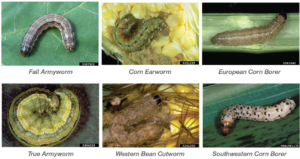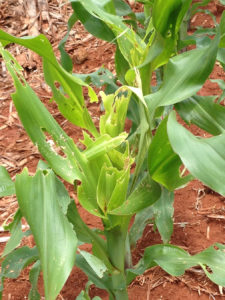Identification
Fall armyworm (FAW) larvae can damage corn at various stages of development by feeding on leaf or ear tissues. FAW larvae are smooth skinned, vary in color from light tan to dark green or black, with three yellow stripes and a dark stripe down the back. There is an equally wide, wavy, yellow stripe, splotched with red next to the dark stripe. Early instar larvae are dark green with black heads and usually found in groups on the plant. Larvae have four pairs of abdominal prolegs and a pair of anal prolegs at the end of the body.1 Full-grown larvae are about 1.5 inches long.(2)
Larvae of FAW, true armyworm (TAW), corn earworm (CEW), western bean cutworm (WBC), European corn borer (ECB), and southwestern corn borer (SWCB) can be mistaken for each other. Correct identification can affect management decisions. To differentiate FAW larvae from other species, look at the head of the larva.
- Fall armyworm larvae heads have a prominent white, inverted Y-shaped mark between the eyes. The FAW larvae vary from light tan or green to almost black.
- True armyworm larvae have a gray or greenish-brown head covered with a network of lines.
- Corn earworm larvae usually have an orange head with no ‘Y’ mark. CEW larvae vary in color ranging from light green or pink to dark brown or nearly black. Early instars are nearly translucent light green and solitary. Bodies have alternating light and dark stripes running the length of the body and double dark stripes down the center of the back. The body is covered by regularly occurring tubercles with two or three stiff black hairs.
- Western bean cutworm larvae are tan with a darker, faint diamond-shaped pattern on their back, and dark stripes immediately behind their head.
- Southwestern corn borer larvae are dull white with a pattern of raised black spots on the body.
- European corn borer larvae have smooth, dirty white colored skin, often having a pinkish tinge, with numerous dark spots scattered over the sides and top of the body. The head is dark brown to black.

Figure 1. Larvae of fall armyworm, corn earworm, European corn borer, true armyworm, western bean cutworm, and southwestern corn borer. Photo of fall armyworm courtesy of Russ Ottens, University of Georgia, Bugwood.org Photos of European corn borer; western bean cutworm; true armyworm; and southwestern corn borer courtesy of Frank Peairs, Colorado State University, Bugwood.org. Photo of true armyworm and corn earworm courtesy of R.L. Croissant, Bugwood.org.
Life Cycle
FAW moths migrate north during the growing season from overwintering sites in South Texas/Northern Mexico and South Florida.3,4 Adult moths lay masses of 50 to 150 spherical, gray eggs on leaves. Life cycle is dependent on temperatures, and larvae hatch in three to five days and initially move into the whorl to feed.1 One generation of FAW requires about 30 and 60 days in the summer and fall, respectively.(3)
Vegetative Damage Symptoms
Late-planted fields in whorl stage are targeted by adult moths for egg laying sites. Young FAW larvae remove the top layer of the leaf and eat through leaves, causing small pin holes. Larvae continue to feed in the whorl, causing leaves to have a ragged appearance as they unfurl from the whorl (Figure 2). FAW actively feed during the day, particularly early in the morning and late afternoon, consuming large amounts of leaf tissue. Larvae can be found deep in the whorl, often protected by yellowish brown frass.
Larval Ear Feeding Damage(5)
Fall armyworm larvae feed by burrowing through the husk on the side of the ear, unlike corn earworm. Larvae also enter at the base of the ear, feeding along the sides and may tunnel into the cob. They usually emerge at the base of the ear, leaving round holes in the husks. Fall armyworm larvae can infest corn from tasseling to the dough stage of growth. Larvae feed on tassels, immature ears, ear shanks, and tunnel into stalks. Heavy infestations of larvae feeding on kernels may result in yield losses. Yield losses may also occur from ear drop and lodging caused by larval feeding damage in ear shanks and stalks.(4)
Scouting
Leaf damage increases and yield potential decreases as more plants are found with egg masses.6 However, scouting for FAW can be difficult. Early FAW damage appears as “window paning” and shot-holes in leaves. Damage from larger larvae results in ragged leaves. As corn ears develop, FAW larvae migrate from the whorls to the ears and damage kernels. If whorl damage exists, scout 20 consecutive plants in five locations of a field.1,2,3 Pull some whorls and unroll the leaves to make larval counts. Begin scouting efforts when corn is near tasseling and silking stages. Look for large larvae in emerging tassels and very small ears. Continue to check closely until silks begin to turn brown.

Figure 2. Severe fall armyworm feeding damage.
Insecticide Applications
If the corn crop planted does not contain B.t. traits offering control against FAW, an insecticide application may be considered. However, the use of insecticides should only be used once the economic threshold has been met. Economic thresholds vary across regions and are dependent on crop stress levels. Control can be considered when (1) egg masses are found on 5% of plants, (2) 25% of plants display damage symptoms with small larvae still present, or (3) 75% of plants have whorl feeding damage.1,2
Consult your local Extension office for economic thresholds in your area. Parasites and beneficial insects can help keep fall armyworm from reaching problematic levels. Look for signs of small white parasite fly eggs laid behind the heads of larvae before deciding to apply an insecticide.
Insecticides should be applied before FAW larvae become larger than 1.25 inches and burrow deep into the whorl or enter ears of more mature plants.2 Insecticides may not be effective if the larvae are burrowed in the whorl because the frass can block the FAW feeding tunnel. High pressure (30 gallons per acre) should be used with ground rig applications of pesticides.(1)
Summary
Fall armyworm has been known to cost farmers hundreds of millions of dollars from corn loss annually.(6) Traited corn products with protection against FAW can help reduce loss. However, it is important to determine which insect is causing feeding damage to move forward with management this year and in the following corn crop.
Article Link – Fall Armyworm in Corn
